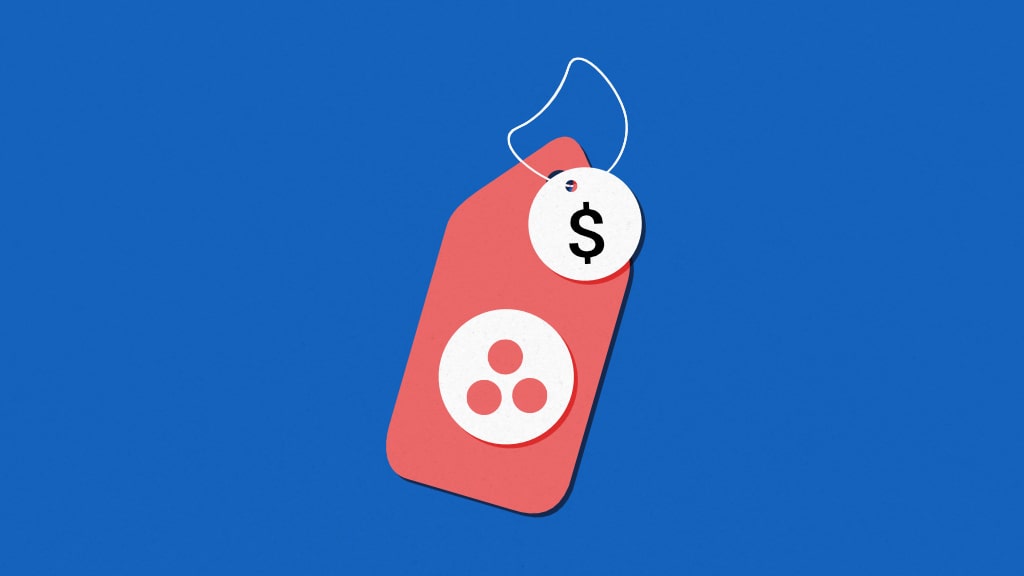Asana—(no, it’s not asana yoga)— it is a project management solution for teams to track project workflow and collaborate to keep the team’s work on schedule. Much like other project management solutions, some of its features include communication, one-on-one or group chats, assigning tasks, and automated reminders.
Teams are using Asana to organize their work, focus on team collaboration and usability. Though Asana has seen several successes, is it worth it? Lately, Asana pricing is a lot in the picture.
Here’s how the X community has reacted to constantly rising Asana pricing:
1. Apparently, Asana pricing is directly proportional to your team’s growth.
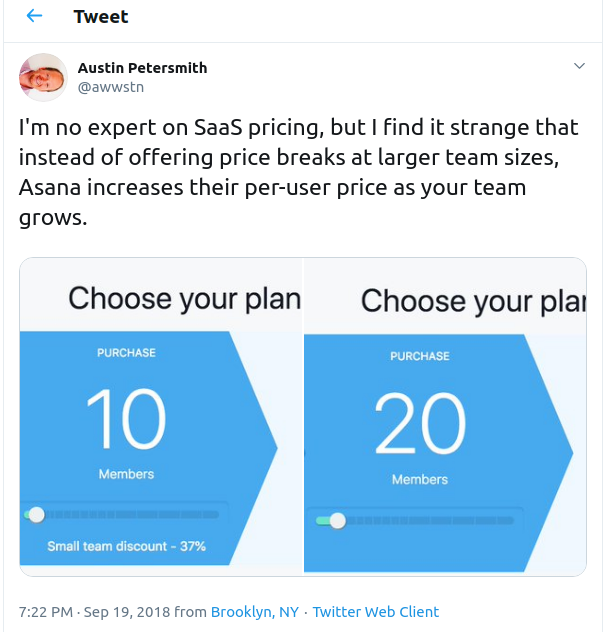
2. It’s definitely not a good idea to announce increase in price when your tool goes through so many outages.
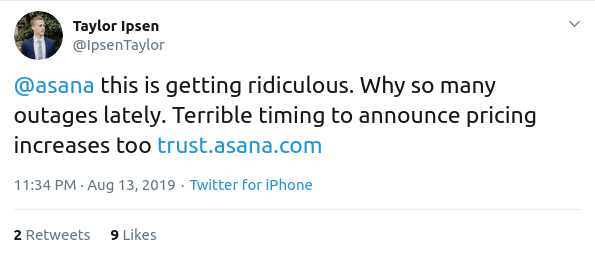
3. And here comes the absolute truth!
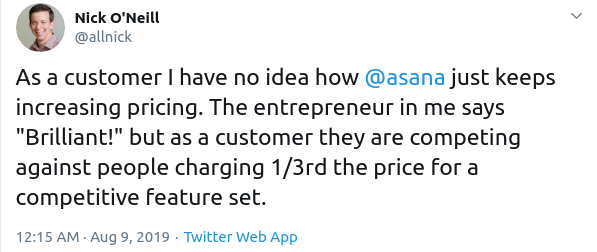
4. There definitely are more powerful and yet lower-priced tools than Asana.

5. There, somebody said it; the whole concept of charging per user is flawed.
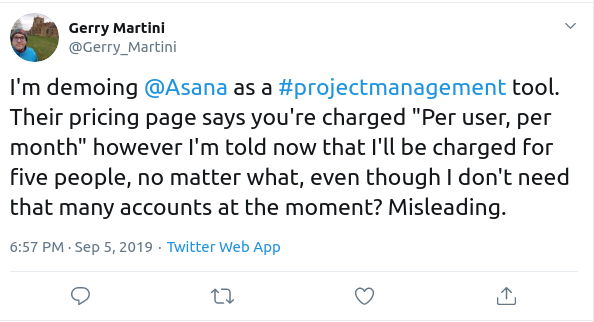
Amidst the tweets, somebody also took over Asana’s forum and expressed their worry about the constantly rising Asana pricing:
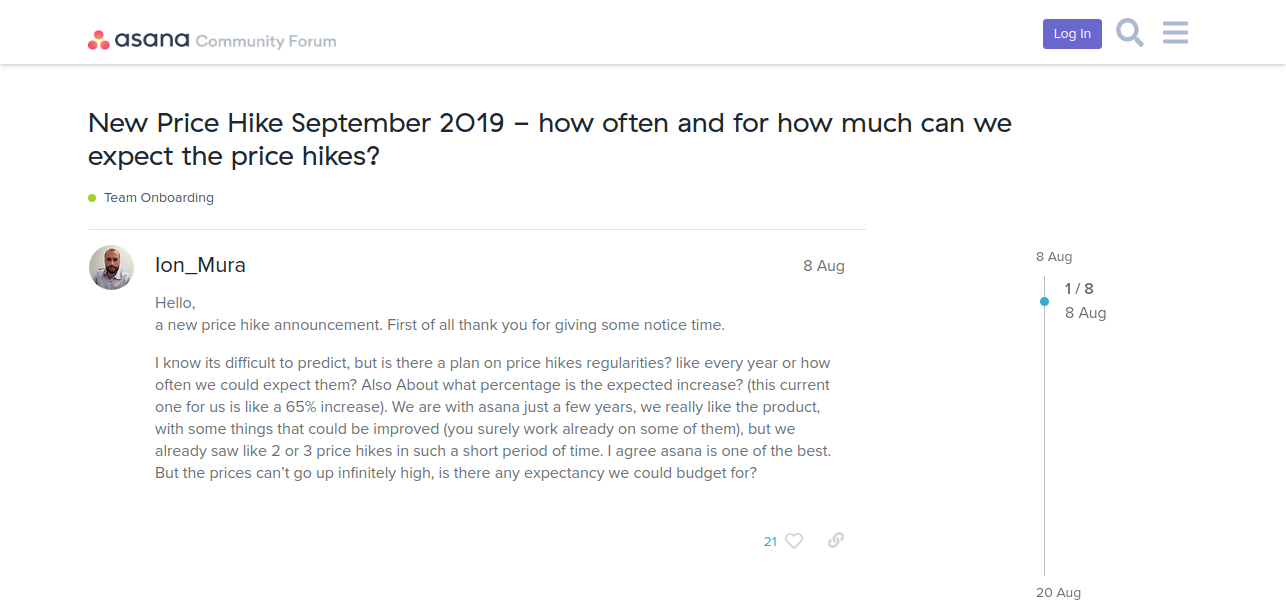
Image Source: https://forum.asana.com/t/new-price-hike-september-2019-how-often-and-for-how-much-can-we-expect-the-price-hikes/57162
Let’s understand the Asana pricing to know what it offers and what others can offer.
What is Asana for?
This little-known startup has been successful in raising money as the founders come from big name-brand tech companies. It has reached a high profile after it reached the 50,000-paying-customers mark building a unicorn territory. It has increased its revenue to the north of $50 million. But is it just all-bark-and-no-bite?
From managing the work of a whole team to handling your personal daily tasks, Asana gives you everything you need to stay in sync, hit deadlines, and reach your goals. But, as discussed earlier, there are teams/individuals becoming disinterested in Asana and approaching Asana alternatives.
ProofHub, a well-known Asana alternative is much more affordable. Let’s first have an overview of Asana pricing and plans, and then compare ProofHub and Asana.
If Asana pricing doesn’t justify, switch to ProofHub. Pay for unlimited users. Try now.
How much is Asana – Asana pricing plans as of November 2023
Asana plans and pricing have changed many times since it started in 2008. There are 4 tiers of Asana: Basic, Premium, Business, and Enterprise. You can always upgrade and downgrade as needed.
The free version of Asana is available for teams of up to 15 people. So, even if you are a team of less than 15 people, you still have to pay for 15. The primary or say most basic purpose of planning projects, delegating work and see WHO’s doing WHAT by WHEN is all supposed to be fulfilled by the free version.
The basic plan:
Manage tasks and personal to-dos:
- Tasks
- List view
- Board view
- Calendar view
- Assignees and due dates
- Collaborate with up to 15 teammates
- Integrate with your favorite apps
Drawback:
Asana pricing is complicated. Yes, they offer a free plan. Asana’s free plan doesn’t provide access to all of Asana’s great features, it provides enough for smaller teams on a budget to get something useful out of Asana (but not much).
And of course, it allows users to collaborate with up to 15 members. Any guests will count as one “member” towards the limit. This seems like a crucial drawback.
The premium plan:
It is $9.99 per user, per month when billed annually, $11.99 when billed monthly. In addition to the features offered in the Basic plan, Premium plan offers:
Track team projects with features and resources like:
- Timeline
- Advanced Search & reporting
- Custom fields
- Custom Templates
- Workflow Rules – Coming Soon!
- Task dependencies
- Milestones
- Admin Console
- Private teams & projects
- Premium content in the Asana Academy
- Customer success onboarding and training (starting for teams over 40)
Drawback:
Asana plan starts in seat increments of 5’s up to 30 seats (5 seats, 10 seats, 15, 20, 25, 30) and then in increments of 10’s (30, 40, 50, 60, and so forth). This is a bit annoying. For individual users and small teams of 1-3 people, you still have to pay for a minimum of 5 seats.
And ProofHub gives ultimate control over unlimited projects for unlimited users and many features including Custom roles, White labeling, Custom workflows, API access for data transport, Project and resource reports, Advanced activity logs, an Account transfer tool, and Priority support all in their Ultimate control plan, giving unlimited users and access to every tool.
The business plan:
Asana’s Business plan starts at $19.99 per user/month when billed annually, and $23.99 when billed monthly. In addition to the features of the Premium plan, the Business plan includes:
- Portfolios
- Lock custom fields
- Ability to build an onboarding plan with Asana’s Customer Success team
Drawback:
Unlimited users, but you must purchase in blocks of 5 users. You can add unlimited guests (those without a company email), but the equivalent “Limited Access Members” now count as paid users for Premium Workspaces. The more plans Asana is adding, the more it becomes complicated to choose one.
While, no matter if you have 30 or 300 users, every ProofHub package offers usage for unlimited people that is $89 /month billed annually. Asana is free for 15 users with limited functionality.
The Enterprise plan:
Asana offers its Enterprise plan for larger teams. It includes all the features of the other plans, plus:
Everything in Business, plus:
- SAML
- User provisioning & de-provisioning (SCIM)
- Data export & deletion
- Block native integrations
- Custom branding
- Priority support
Pricing for the Enterprise plan is not publicly available, so you’ll have to contact Asana directly for a price quote.
Almost all these features are part of ProofHub’s Ultimate control plan which is available at a fixed price of $89/month billed annually for unlimited users. And never have the users faced a weird hike in ProofHub pricing as they have for Asana.
Here’s a quick comparison of Asana and ProofHub features and pricing:
What’s best for you?
Asana pricing is a concern. What’s the best alternative to pay less? Here’s a quick comparison of Asana and ProofHub features and pricing:
ProofHub’s standard plan
- $45 per month for 5 users and unlimited projects (billed annually)
- $50 per month for 5 users and unlimited projects (billed monthly)
Asana’s business plan
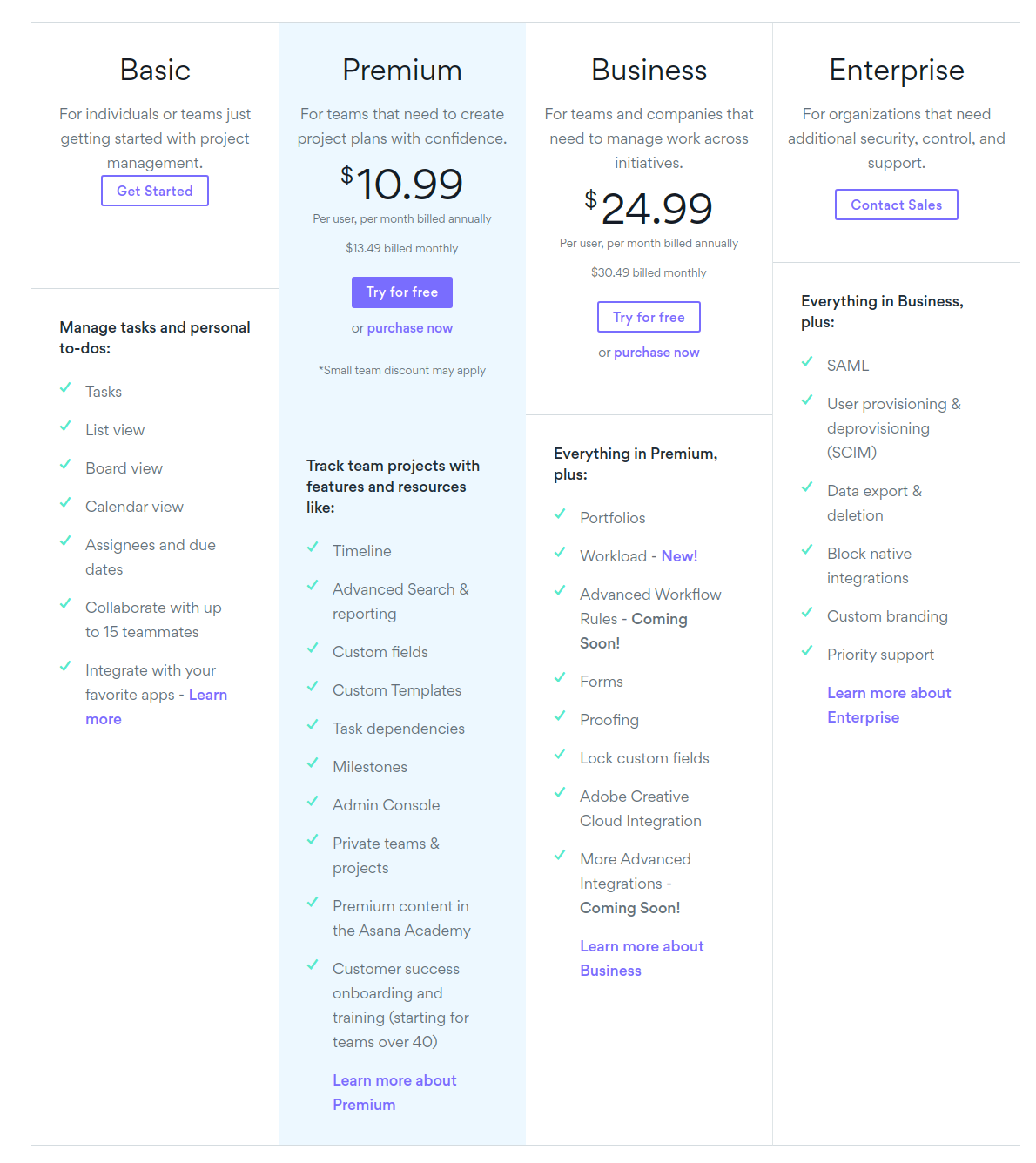
- $19.99 per user, per month, billed annually. This means $99.95 for 5 users (hereas ProofHub’s standard plan offers Flat $45 per month for 5 users).
- $23.99 per user, per month, billed monthly. This means $119.95 for 5 users (whereas ProofHub’s standard plan offers Flat $50 per month for 5 users).
Asana charges on a per-user (also known as per seat) basis. This brings a higher cost compared to flat fees, it allows companies to scale their service fairly between smaller teams and larger corporations.
Not convinced yet? Try ProofHub for yourself. Sign up for free.
ProofHub and Asana: What’s the comparison?

1. Pre-built project templates
ProofHub: Using ProofHub create project templates and save them to create similar projects without having to fill in details from scratch. You can convert an existing template to a project and make any changes.
Asana: Asana provides templates, though with a few limitations. Choose from a set of eight different project templates. Only two of the templates are free.
2. Task and subtask
ProofHub: Tasks and subtasks in ProofHub are to-dos that are added to the task list. Different due dates and assignees are added to the subtasks.
Asana: Subtasks are like an independent task but in the parent task. Asana’s subtask does not take its parent task’s assignee, or due date, nor is it automatically associated with the project.
3. Task dependencies
ProofHub: Gantt charts in ProofHub help to plan projects, modify schedules, and visualize tasks in a timeline view. See overlapping tasks and task dependencies to make sure project deadlines are met.
Asana: If you want the ability to create task dependencies with Asana, you’ll have to use the Premium version
4. Kanban
ProofHub: Kanban boards in ProofHub allow to visualize workflow and add labels, set the start and due dates, set time estimates, track time spent, create recurring tasks, and attach files at one place.
Asana: Asana has Kanban boards that use columns and cards to visually plot projects and workflows and visualize the progress of each project as well as spot roadblocks.
Give Kanban boards a try. Sign up now.
5. Custom reports
ProofHub: You can create a custom project status with parameters of your choice in your project using ProofHub. It gives a visual roadmap timeline of the complete and incomplete milestones and manages projects accordingly. Add project status easily with just one click.
Asana: Asana and Google Sheets integration lets you use your Asana portfolio data to build custom reports.
6. Request forms
ProofHub: Managing your request for work can be done easily using ProofHub. You can send a customized request form to get the information required. Paste the link of the request form anywhere and get requests directly added to ProofHub from support queries to tickets to any type of work request.
Asana: Asana forms can be used by external or internal teams. It comes with two default questions, name, and email, to ensure you get the right information of the people who are requesting work.
7. Dashboards
ProofHub: ProofHub dashboard looks super clean and uncluttered letting users make work as simple and easy as possible.
Asana: Dashboard capabilities in Asana are available on the new portfolio feature, but it is only available for enterprise accounts and you’ll pay to double the cost for it.
8. Charts and visualization
ProofHub: Gantt charts help the team plan projects easily, modify schedules, and visualize tasks in the timeline view. Set task dependencies and highlight the critical path to see the status of tasks at a glance that directly affects the start and end date of a project.
Asana: A portfolio feature is available for paid accounts to have a 360-degree view of your projects. You can identify any risks and dig into specific projects’ details to make adjustments to meet deadlines
9. Proofing
ProofHub: Review and proof files easily and faster with ProofHub’s proofing tool. Collaborate in real-time on files and documents. Annotate files with markup tools. Reply to comments within a thread and upload new versions of the file for comparison.
Asana: Make visual feedback by leaving specific, actionable feedback on images in order to finalize the work.
Recommended reading: Asana vs ProofHub
Should you pay for Asana?
Why pay for Asana when you can pay less when using other project management tools? You can save many dollars with Asana alternatives and that will be worth paying for.
So, whether you are a new user to Asana or a user who is done with all the hikes in its price lately. You can try ProofHub free for 14 days and after that opt for the fixed price plans, and sign up for ProofHub today.
